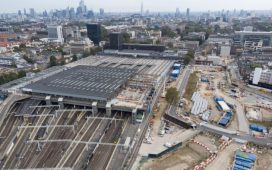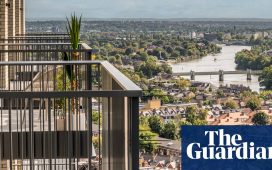Stay informed with free updates
Simply sign up to the UK property myFT Digest — delivered directly to your inbox.
London remains the UK black spot for housing affordability, even after a five-year period of improvement in which earnings caught up with rent, according to official data.
Housing costs accounted for 35 per cent of tenants’ income in the capital in the year to March 2022, the Office for National Statistics said on Monday. This made it the only region in the UK with a rent-to-income ratio above 30 per cent, the threshold at which the ONS considers an area unaffordable.
Its finding is alarming because London rental prices, already the highest in the country at an average £1,450 per month, have been rising at a record rate this year after largely stagnating for the last four years, creating new affordability pressures.
The previous peak in London’s rental problem was in 2017, when the ratio of rental prices to wages reached 50.3 per cent. But the latest data shows the ratio remains as high as 46 per cent in the capital for poorer households.

In contrast, private tenants in England spent an average of 26 per cent of their income on rent, based on median household income and median rental costs, in the 12 months to the end of March last year. In Wales, the figure was 23 per cent, while in Northern Ireland it was 25 per cent.
The ONS said separate data has shown a clear pattern of house prices increasing faster than incomes and UK inflation since 2013, but added that across the UK “no such clear pattern can be shown for private rents and the income of private renting households”.
London rental prices have contracted for most of 2018 and 2021 and largely stagnated in 2019, but they have grown at an accelerating pace since the middle of 2022.
Separate ONS figures released last week showed that on average UK rents increased at an annual rate of 5.7 per cent, with London registering an increase of 6.2 per cent, the highest since the data series for the capital began in January 2006.
“The UK is facing an accommodation affordability crisis, particularly in London,” said Victoria Scholar, head of investment at Interactive Investor, an online investment service.
A regular ONS survey published on Friday found 43 per cent of respondents found it difficult to afford rent or mortgage payments, up from 30 per cent in October last year.
Martin Beck, chief economic adviser to the EY Item Club, said nominal wage growth has supported incomes over the past year, but added “younger people, whose wages have grown relatively slowly in recent years and who are more likely to rent, have experienced a fall in affordability”.
Rents are rising in part because of an increase in demand as a sharp jump in mortgage costs has made buying a property unaffordable for many, especially first-time buyers. Landlords in turn have passed on their higher borrowing costs to tenants.
Andrew Wishart, economist at Capital Economics, said supply was also being squeezed because “highly leveraged landlords” were being forced to sell some of their properties when they refinanced. He said the poor rental returns on offer were also putting landlords off purchasing new flats.
Tom Bill, head of UK residential research at Knight Frank, said another factor driving up rents was the government’s decision to target landlords with extra red tape and taxes over the past decade because it was “politically expedient”.
Bill said he did not expect the supply and demand mismatch would “end any time soon, which will keep upward pressure on rents in the medium term”.










